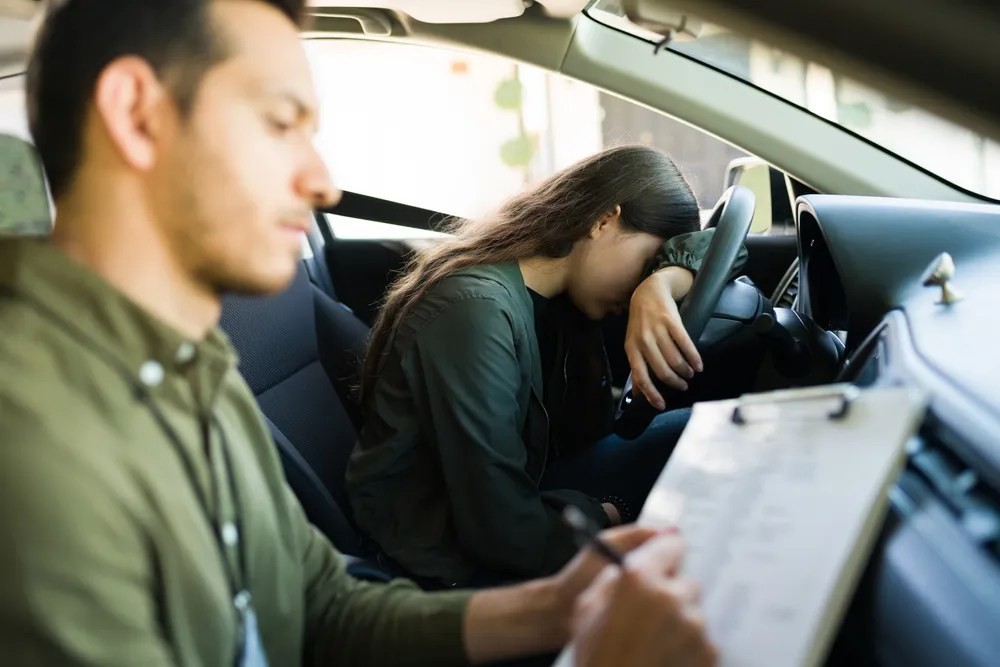Rolling Stops
One of the most common mistakes to avoid during your DMV road test is making incomplete stops. Many drivers slow down, but do not actually come to a complete stop during the road test. You must come to a full stop, and behind the demarcation line. Be sure to stop before the line.
Improper Lane Changing
It’s not terribly difficult to signal your intention to change lanes, then check your mirrors and blind spot before changing lanes, however people fail to do it all the time, including during the DMV test. Be sure to change lanes properly! When your DMV test giver tells you to change lanes, first look, turn on your signal, check your rear view and side mirrors, turn your head to check for a car, truck or motorcycle in your blind spot, and only when it is clear should you change lanes. Be sure to watch out for traffic in front of you, too, and keep your speed up.
Lack of Steering Control
Although demonstrating confidence behind the wheel is important during your test, don’t be so confident that you drive one-handed. Keep both hands on the wheel when possible. Make hand-over-hand turns, and release from the turn with controlled slippage.
Distracted Driving
Keep your cell phone and stereo off during your driving test. This is common sense, but it is surprising how many people are thinking or fidgeting with other things while taking their test. Focus on the task at hand, and keep your mind on the road. 5 Confusion at Four-Way Stops When you come to an intersection with stop signs, especially at four-way stops, be sure you know what to do if there are other cars waiting at the intersection. Wait your turn, then go. Be sure to signal your intentions if you are turning. Generally, if two cars arrive at an intersection at the same time, the car to the right goes first.
Confusion at Four-Way Stops
When you come to an intersection with stop signs, especially at four-way stops, be sure you know what to do if there are other cars waiting at the intersection. Wait your turn, then go. Be sure to signal your intentions if you are turning. Generally, if two cars arrive at an intersection at the same time, the car to the right goes first.
Improper Freeway Merging
It is unlikely that your DMV test administrator will take you onto the freeway, but should it happen, know how to merge safely from the entrance ramp into traffic at speed. Many beginners stop at the end of the ramp rather than merging, causing an unsafe situation. 7 Driving Too Slowly During your DMV test, it is important to display confidence. Being overly careful by driving considerably below the speed limit can cause unsafe conditions for yourself and other drivers.
Driving Too Slowly
During your DMV test, it is important to display confidence. Being overly careful by driving considerably below the speed limit can cause unsafe conditions for yourself and other drivers.
Driving Too Fast for Conditions
There are times when it is not safe to drive at the speed limit. If there is rain, fog, an accident or traffic congestion, slow down to a safe speed.
Changing Lanes in an Intersection
Do not change lanes when passing through an intersection, whether you are going straight or making a turn. Even if the lane is clear and you are following the rules for proper lane changes, never do it in an intersection. Wait until you are safely past the intersection to make the lane change.
Changing Lanes in an Intersection
Do not change lanes when passing through an intersection, whether you are going straight or making a turn. Even if the lane is clear and you are following the rules for proper lane changes, never do it in an intersection. Wait until you are safely past the intersection to make the lane change.
Braking Too Hard
Make sure you are familiar with how soft or hard the brakes are in the car you will be using during your DMV test. Hard braking is acceptable in emergency situations, but while slowing down or stopping, use just enough brake to get the job done, but not so much that you and your passenger are thrown forward.
Following Too Closely
Be sure to stay several car lengths behind the traffic in front of you. Keep a safe distance so that if the car in front of you swerves or brakes, you will have enough reaction time to keep you and your passengers safe from harm.
Driving Too Fast
Stay within the speed limit even if other drivers are driving faster. Be aware of drops in the speed limit as well, especially in school zones, work zones and other special speed limit areas.
Parallel Parking
If your state requires demonstration of parallel parking ability, the main factors to watch out for are not to hit other cars or to run over the curb. It is fine to touch the curb, but don’t roll over it. Even if you get points taken off for not successfully parallel parking your car, as long as you don’t hit a car or the curb too forcefully, you should still pass your test.


